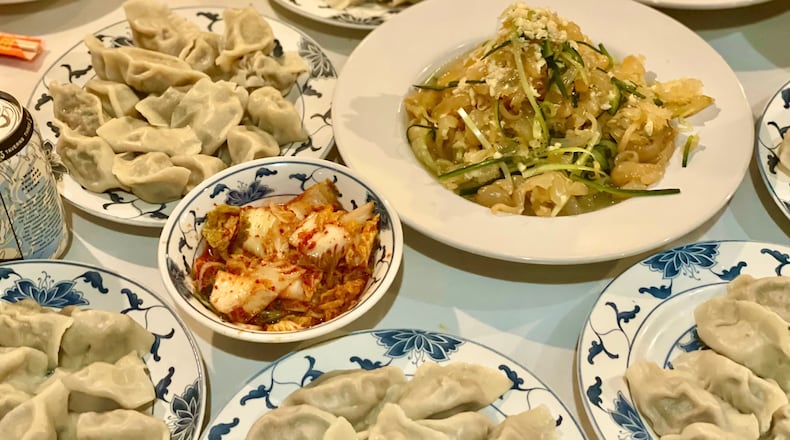The humble dumpling has universal appeal. Cooks in almost every culture bundle sweet or savory fillings in balls of dough, and have different methods of cooking them — boiled, steamed, fried or baked.
Credit: Erik Meadows
Credit: Erik Meadows
Dumplings are a way to stretch scanty ingredients, as well as a mode of celebration. What is peasant food to one is festive luxury to another. And, they have been around for thousands of years, whether you attribute them to China’s Han Dynasty or to the Neolithic people of ancient Persia.
The dumpling is a lingua franca of food, bridging our commonalities. In Atlanta, we are lucky to have dumpling variations ranging from Brazilian coxinhas to Nepalese momo.
Credit: Angela Hansberger
Credit: Angela Hansberger
In ancient China, physician Zhang Zhongjing attempted to cure a febrile/frostbite condition in his village with meat, peppers and medicinal herbs wrapped in scraps of dough. He shaped them into “tender ear” (jio er) shapes and boiled the dumplings — now called jiaozi. Ossified jiaozi from the Tang Dynasty, resembling the dumplings eaten today, were unearthed from a tomb in Turpan.
You can try a plate of jiaozi at Golden Buddha (1905 Clairmont Road, Decatur. 404-633-5252, goldenbuddhaga.com), where the steamed dumplings consist of pleated dough that is folded, stuffed with ground pork and chopped vegetables, and pinched along the top.
Credit: Handout
Credit: Handout
Dumplings are found throughout Asia. Japanese pan-fried versions, called gyoza, often are steamed, then crisped in a pan. “It’s a comfort food, where each family has their own recipe and ratio of ingredients,” said Sachi Takahara, who serves her grandmother’s recipe at Nakato (1776 Cheshire Bridge Road NE, Atlanta. 404-873-6582, nakatorestaurant.com).
Momo are the fried or steamed dumplings of Nepal and Tibet. You can try both a steamed chicken momo and a spicy fried version at Himalayan Spice (3145 Briarcliff Road NE, Atlanta. 404-549-7602, himalayanspiceatlanta.com).
Korean mandu often include kimchi and/or tofu. Stone Bowl House (5953 Buford Highway NE, Atlanta. 678-530-0844, stonebowlhouse.com) is a great place to try them, both poached and pan-fried.
Sichuan-style Zhong dumplings are named for the family that first made them in Chengdu more than 100 years ago. At Yummy Spicy (5164 Buford Highway NE, Doraville. 770-680-5605, yummyspicygatogo.com), the folded, moon-shape dumpling is filled with pork and scallions, then boiled and tossed in red chili oil and soy sauce.
Credit: Steve Jou
Credit: Steve Jou
Shumai have their origins in inner Mongolia. The pinched-together dough with an open top usually holds pork and shrimp, and can be found on decadent dim sum carts, as well as for takeout. On Thai menus, they are known as kanom jeeb, and Surina Thai (2390 Chamblee Tucker Road, Doraville. 770-609-6321, surinathai.com) serves them generously packed with chicken, shrimp and pork, and dipped in sweet chili-garlic soy sauce.
Also frequenting dim sum carts are har gow, little bonnets of opaque tapioca skin stuffed with shrimp. You can find them, made from a family recipe, at Pyng Ho (1357 Clairmont Road, Decatur. 404-634-4477, pynghorestaurant.com).
Credit: Angela Hansberger
Credit: Angela Hansberger
Add soup to a dumpling, and you’ve got xiao long bao. An excellent version, filled with crab roe and pork, can be found at Northern China (5141 Buford Highway, Doraville. 770-458-2282, northernchinaeatery.com).
Mixing sweet and savory, chau maung are tapioca flour-skinned dumplings filled with minced chicken and ground peanuts, traditionally served to the Thai royal family. The delicate rose-shaped beauties are available at Nan Thai Fine Dining (1350 Spring St. NW, Atlanta. 404-870-9933, nanfinedining.com).
Credit: Molly Gunn
Credit: Molly Gunn
Poland’s national dish, pierogi, is on the menu at the Porter Beer Bar (1156 Euclid Ave., Atlanta. 404-223-0393. theporterbeerbar.com), where the potato-filled crescents of dough accompany wild mushrooms, cranberries and sage in brown butter.
Ravioli, commonly square dumplings composed of a filling between two layers of egg pasta, date to 14th century Venice. In Sardinia, culurgiones are potato-filled, much like a pierogi, but with intricate braiding of the dough. Craig Richards of Lyla Lila (693 Peachtree St. NE, Atlanta. 404-963-2637, lylalilaatl.com.) makes artistry of both. He binds the filling of his silken purses of beef and black truffle ravioli, braised with vegetables and herbs, using Parmigiano-Reggiano and eggs, and plates them with a simple sauce of pasta water, butter and thyme.
Credit: Andrew Thomas Lee
Credit: Andrew Thomas Lee
Using leftovers gave rise to gnocchi (Italy), haluski (Czech Republic), kroppkakor (Sweden), pitha (Bangladesh), samosa (India) and the Jewish kreplach. In 19th century France, Georges Auguste Escoffier is said to have written down a recipe for recycling leftovers that came to be known as croquettes. The round mass of minced meat and mashed potato, coated in egg and breadcrumbs, was deep fried, with its name coming from the French croquer, meaning “to crunch.”
The recipe made its way to Spain, where croquetas were filled with bechamel, instead of potato. “The combination of textures is comforting, with the crunch of the shell and the creamy bechamel,” John Castellucci said of his pork cheek croquetas served at Cooks & Soldiers (691 14th St. NW, Atlanta. 404-996-2623, cooksandsoldiers.com).
Brazil’s coxinhas provide a similar crunch and stretching of ingredients. Molded into a shape to resemble their namesake “chicken thigh,” they have shredded chicken in breaded and fried dumplings. The coxinhas at Brazilian Bakery (1260 Powers Ferry Road, Marietta. 770-818-0088, brazialianbakerycafe.com) are delectable, with chicken, mozzarella and green onion.
Far and near, past and present, these filled bits of dough show just how similar we all are.
Sign up for the AJC Food and Dining Newsletter
Read more stories like this by liking Atlanta Restaurant Scene on Facebook, following @ATLDiningNews on Twitter and @ajcdining on Instagram.
About the Author
The Latest
Featured









